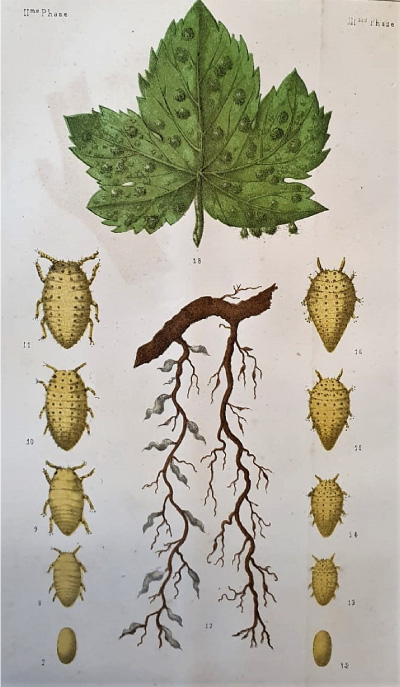
2020 The International Year of Plant Health
Many people celebrated the new year of 2020 with wine. In everyday life or just at festive times, wine consumption has become essential for millions around the world. Given the current success, it is hard to imagine that 150 years ago wine was threatened with extinction.
Inexplicably, in the mid-nineteenth century, the vineyards began to die, first in France and then in other countries. Both farmers and scientists from different scientific areas have embarked on research and experiments to solve the problem. Fighting Phylloxera vastatrix, the American insect that was causing the death of vineyards in Europe, led to profound changes in viticulture. The solution required a combination of several strategies, which included introducing a hybrid strain into the soil (with insect-resistant roots) and grafting this plant with local varieties of Vitis vinifera. Phylloxera still exists, but it no longer affects the old vine varieties!
Stages of the phylloxera biological cycle: the insect starts at the roots and rises to the leaves of the vine. Print published by O Agricultor do Norte de Portugal. Jornal de Agricultura Prática (The Farmer of Northern Portugal. Journal of Practical Agriculture) in 1874.
If, for now, the vineyards are not threatened, the same is not true for many essential plants, such as olive trees, cashew nuts or banana. In proclaiming 2020 as The International Year of Plant Health, the United Nations considers this to be an “opportunity to raise global awareness on how protecting plant health can help end hunger, reduce poverty, protect the environment, and boost economic development”.
The Food and Agriculture Organization estimates that plant diseases today are causing 40 percent of annual food losses. For backward historical periods, it is more difficult to make accurate calculations, but the records bear witness to the weight of the constant threat. As the book Famine in European History, edited in 2017 by Guido Alfany and Cormac Ó Gráda, shows, diseases and pests are often combined with other factors to bring about catastrophe.
The problems related to diseases of cultivated plants are as old as agriculture. At the origins of biotechnology are the selection and combination of seeds made by the first farmers, who sought those that resisted the pests and guaranteed the best crops. While this search for resistant seed varieties is now mainly closed in a few university labs and large biotechnology companies, for millennia this knowledge has been widespread among millions of farmers around the world. It is to them that we owe the development of local seed varieties, with great genetic variability and able to adapt to the agro-ecological characteristics of the different regions. The disappearance of these farmers, particularly in Europe, means the destruction of these informal laboratories and the loss of ability to adapt crops to ongoing climate and ecological changes. These are current challenges that require reflection and solutions.
From the second half of the nineteenth century, with the intensification of intercontinental contacts and the widening of monoculture areas, the impact of plant diseases and pests also became a global problem. From the great famine in Ireland caused by the death of potato crops to the destruction of orange production and export in the Azores or the spread of phylloxera in wine-producing countries in Europe, the scale of the problems crossed borders.
Action
For decades, discussions, experiences, proposals, and initiatives intersected to ensure problem-solving. Since the late nineteenth century, transnational mechanisms have been put in place to stop the introduction and spread of diseases and pests. These include the establishment of scientific research organizations dedicated to plant health, the signing of international agreements regulating the circulation of plants and food, including border and cargo surveillance.
The last century has been equally marked by the development and indiscriminate application of chemicals to attack the unwanted plant and animal weeds. After a time when the negative effects of pesticides on the environment and public health were ignored, the evidence required national governments and international organizations to act to ban some of these products. Rachael Carson’s warnings in the pioneering book Silent Spring, released in the early 1960s, had some echo. But if DDT is no longer allowed, glyphosate and many others continue to be used.
By focusing on plant health during 2020, the United Nations and FAO propose an ecosystem approach. They argue that “this ecosystem approach combines different management strategies and practices to grow healthy crops while minimizing the use of pesticides. Avoiding poisonous substances when dealing with pests not only protects the environment, it also protects pollinators, natural pest enemies, beneficial organisms and the people and animals who depend on plants”. Looking at solutions to today’s plant health problems from this perspective, what can we learn from the legacy of past knowledge and experience?


0 Comments